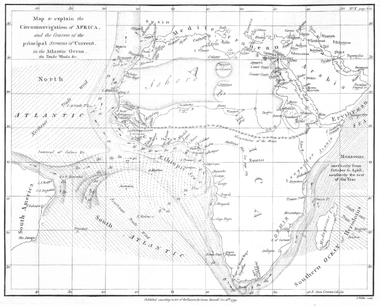Aethiopian Sea

Aethiopian Sea (Æthiopicum Mare in Latin) was the name given to the southern part of the Atlantic Ocean in classical geographical works from ancient times to the 19th century. The term Aethiopian was also used at the time to describe un-inhabitable parts of Sub-Saharan Africa.
DXescription
The Aethiopian Sea, Ethiopic Ocean or Ethiopian Ocean (Okeanos Aithiopos), is an old name for what is now called the South Atlantic Ocean. It is separated from the North Atlantic Ocean by a narrow region between Natal, Brazil and Monrovia, Liberia. Use of this term was analogous to referring to the continent of Africa by Aethiopia. The modern nation of Ethiopia in northeast Africa, is nowhere near the Ethiopic Ocean. The term Ethiopian Ocean appeared until the mid-19th century, as e.g. on the map The Dutch colony of the Cape of Good Hope by L.S. de la Rochette, MDCCXCV", published by W. Faden in London in 1795.
History
Ancient Greek historians Diodorus and Palaephatus mentioned that the Gorgons lived in the Gorgades, islands in the Aethiopian Sea. The main island was called Cerna and, according to Henry T. Riley, these islands may correspond to Cape Verde.[1]
On 16th century maps the name of the Northern Atlantic Ocean was Sinus Occidentalis, while the central Atlantic, southwest of present-day Liberia, appeared as Sinus Atlanticus and the Southern Atlantic as Mare Aethiopicum.[2] John Seller in his Atlas Maritimus divided the Atlantic Ocean in two parts by means of the equator. He called the northern portion of the Atlantic "Mar del Nort" and the southern part "Oceanus Æthiopicus". Edward Wright did not label the North Atlantic at all but called the portion south of the equator the "Aethiopian Sea" in a map that was published posthumously in 1683. John Thornton used the term in "A New Map of the World" from 1703.[3]
Botanist William Albert Setchell (1864–1943) attributed the term to the sea around certain islands close to Antarctica.[4]
See also
- Ethiopia (mythology)
- Gorgons
References
- ↑ Ovid, The Metamorphoses, commented by Henry T. Riley ISBN 978-1-4209-3395-6
- ↑ Georg Heinrich von Boguslawski, Handbuch der Ozeanographie, 1907.
- ↑ Ian K. Steele, The English Atlantic, 1675-1740: An Exploration of Communication and Community, Oxford, ISBN 978-0-19-503968-9
- ↑ Studies of South African Phaeophyceae. I. Ecklonia maxima
External links
- Transactions and Proceedings of the Royal Society of New Zealand 1868-1961
- Anais do Museu Paulista: História e Cultura Material - Do oceano dos clássicos aos mares dos impérios: transformações cartográficas do Atlântico sul
- "Tekeli-li" or Hollow Earth Lives: A Bibliography of Antarctic Fiction
- Pomponius Mela, de Chorographia Liber Primus